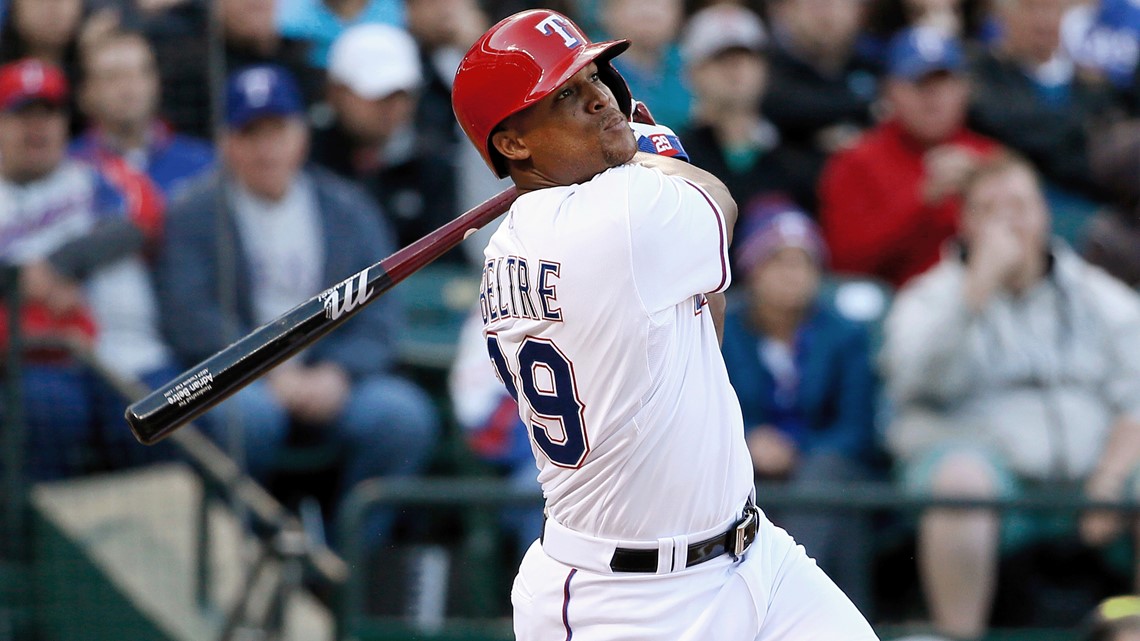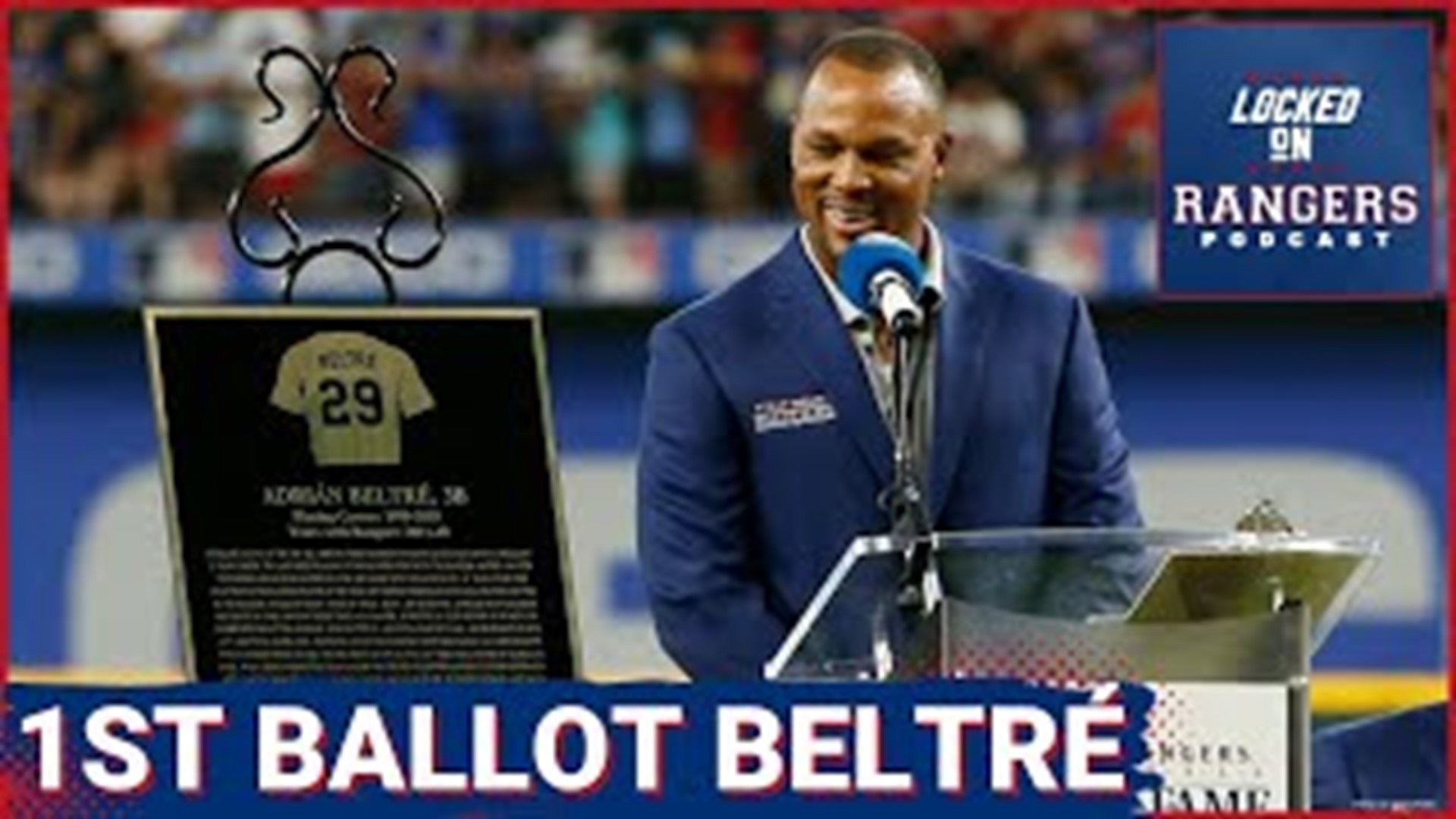DALLAS — By Tuesday night, Adrian Beltre will be a first-ballot Hall of Famer.
Nothing about those words should come as a surprise. The former Rangers third baseman has been tracking at more than 98% of the vote -- well above the 75% threshold for induction -- and the few holdouts in supporting his induction have drawn as much scorn as Baseball Twitter can muster (for the middle of winter anyway).
No, Beltre's secured place in Cooperstown is not breaking news.
But consider this nugget from his journey: Beltre debuted in the majors in 1998, at 19 years old; he didn't make an All-Star team until 2010, at 31.
I love that note about Beltre.
I love what it says about the ballplayer, and how he got here.
I love how it reminds us that this sure thing -- this near-unanimous selection to baseball's most hallowed ground -- wasn't always so sure.
I love that it sets up perfectly how he became our guy here in Texas.
I'll try to explain some of that journey here, the best I can. But call it a testament to Beltre's durable greatness -- and to the game, as a whole, for finally recognizing it -- that he not only will land in the Hall of Fame, but will get there by a landslide, and on the very first time around.
I think there's often a misconception about Hall of Famers -- that they are anointed early, and that every step of their career follows a path directly to Cooperstown.
Beltre bucks this notion, and that's the beauty of his story.
He stumbled early, lost his footing and took a more anonymous route than the household names of his era.
And yet his career endured.
His numbers won out.
His legacy was written on his time.
On the 2024 ballot, Beltre was the easiest choice. Former Twins catcher Joe Mauer and Rockies first baseman Todd Helton also appear comfortably bound for Cooperstown. Meanwhile, slugger Gary Sheffield and closer Billy Wagner -- both in their last years on the ballot -- could find their way in, too.
When this group gathers for induction in July, it's Beltre who will lead the class. And when the Hall of Fame unveils his bronzed plaque, he'll be wearing a Texas Rangers cap.
It's only fitting. Beltre's greatness was always there. He just never realized it elsewhere as much as he did in Texas.
He arrived in Texas in 2011 as one of the top free agents in baseball. But his career, to that point, had been uneven and somewhat overlooked.
In Arlington, he played too good to be ignored.
Beltre slashed .305/.357/.509 in eight seasons for the Rangers, and collected 1,277 hits -- including 199 homers.
He finished seventh or better in the MVP voting four times in Texas. He won three Gold Gloves and two Silver Sluggers here. He even led the league in hits in 2013.
In short, he put it all together -- the fielding brilliance at third base, and the power and average at the plate.
Throw in the regular moments of hilarity, be it dodging Elvis Andrus’ head pats or trolling umpires from the on-deck circle, and Beltre quickly became an all-time Ranger. He belongs right up there with the likes of Nolan Ryan, Michael Young and Ivan Rodriguez.
It’s no stretch to say Beltre’s torrid run in Texas is what made him a no-doubt-about-it Hall of Famer.
And, sure, perhaps it would have happened somewhere else, too.
But it didn’t. And, to that point in Beltre’s career, it rarely had.


Before signing with the Rangers, Beltre had flashed all three of his elite skillsets — fielding, power, hitting for average — at various points in 14 seasons with the Dodgers, Mariners and Red Sox.
They just hardly seemed to converge all at once.
He also hit a few roadblocks early in his career. In 2001, he suffered through a botched appendectomy in the Dominican Republic. As Joe Posnasnki detailed in “The Baseball 100,” Beltre spent weeks in the hospital, lost 34 pounds and had to undergo multiple surgeries.
What followed on the field was three seasons of a funk.
Take 2003, for example. Beltre, then 24 and already in his fifth full season, accumulated 2.8 wins above replacement (WAR) as a fielder. That's a fancy way of saying: He was among the best defenders in all of baseball.
But he also hit .240 with an on-base percentage of .290, both well below league average marks.
The next year, in 2004, Beltre hit .334, blasted 48 homers and drove in 121 runs, finishing second in the MVP voting behind only Barry Bonds.
Those two years kind of summed up the Adrian Beltre Experience of the 2000s. He was always an elite fielder, even though advanced analytics that highlighted such skill, like WAR, weren’t as widely appreciated then as they are now. But his hitting came in waves -- elite one year, middling the next.
He had a few decent seasons with the Seattle Mariners from 2005-2009, but nothing close to that near-MVP season of 2004.
The turning point seemed to come in 2010, when Beltre signed a one-year deal with the Boston Red Sox. Playing in the hitter-friendly Fenway Park, Beltre hit a blistering .321 with 28 homers, 105 runs batted in and a league-high 49 doubles. That’s not to say the ballpark told the story, though: Beltre’s adjusted on-base percentage (OPS+), which accounts for ballpark factors, was 141 -- his highest since 2004. He made his first All-Star Game that season, finished ninth in MVP voting and won a Silver Slugger Award.
Then it was on to Texas.
The Rangers were coming off their first World Series appearance that season, having just lost to the San Francisco Giants. Signing Beltre -- and, in effect, sliding Michael Young into a designated hitter role -- was the type of move that was meant to put a contender over the top and earning a team a title.
We don’t need to talk about how that did or did not happen.
Just know this: The Beltre move was an overwhelming success for the Rangers — and for Beltre, too.
His 2011-2017 seasons were the best stretch of his career. He hit .300 or better in five of those seven seasons (and .296 and .287 in the other two), and the advanced metrics also told story: He was one of the best players in Major League Baseball.
His on-base plus slugging percentage was .877 in that 2011-2017 stretch, and he racked up 39.6 wins above replacement (WAR) in that time, elevating him from elite defender with the occasional bat to an honest-to-goodness all-time great.
But here’s the really interesting part of Beltre’s career: He ultimately appealed to all facets of baseball analysis -- to both the traditional stat counters and the sabermetric gurus.
While he racked up an historic amount of wins above replacement -- 93.5, according to Baseball Reference, good for top 30 all-time -- even WAR’s detractors (and there are plenty) could find something to love about Beltre’s resume.
He hit at or near .300 with regularity, he drilled doubles at a top-of-league level and he thrilled in the field, holding down the hot corner with fundamentals and flash.
He played with joy, the effervescent kind an entire ballpark could feel.
I mean, the guy made the on-deck circle fun. The on-deck circle!
On July 26, 2017, umpire Gerry Davis issued a mid-game warning to Beltre as he was standing on deck while the Rangers were losing 18-6. Davis asked Beltre to move back to the actual on-deck circle -- a vinyl mat near the dugout -- but Beltre liked his spot better.
So, he went over to the mat and dragged it to where he was standing before Davis had told him to move.
Beltre then hilariously continued his on-deck routine, and everyone in the ballpark laughed -- except Davis, who tossed Beltre from the game.
Thing is, Beltre's week was just getting started.
Just four days later, he stepped to the plate against Orioles lefty Wade Miley and laced a fastball down the third-base line for a standup double.
It was his 3,000th hit.
Beltre didn’t need to reach that coveted plateau to validate his career. He’d have found his way to the Hall of Fame either way -- and still likely on the first ballot. But it was another credit to his durability, and another moment that indebted him to Rangers fans, who gave him a standing ovation on a scorching Sunday afternoon as he reached it.
(Sidenote: It's also something baseball likely won’t see too often again. Miguel Cabrera, now retired, hit the 3,000 mark in 2022. No active players are close to that mark at the time of this writing.)
Beltre retired after the 2018 season, deciding to hang it up after “many sleepless nights,” he said.
T.R. Sullivan, then the Rangers beat writer for MLB.com, put Beltre’s legacy into perspective at the time:
Among third basemen, Beltre has few peers. In addition to being the only player at his position with both 3,000 career hits and 400 homers, he leads all third basemen in career hits and RBIs, and ranks third in home runs behind only Mike Schmidt (548) and Eddie Mathews (512).
Not bad for a guy who didn’t make an All-Star Game until his 30s.
The one blemish on Beltre’s Rangers tenure is the one blemish we all think about from 2011, when everything fell apart on a chilly night in St. Louis.
So it was refreshing to see Beltre --- along with his teammates Michael Young and Ian Kinsler -- on the field this past November after Game 5 in Arizona, basking in the glow of the franchise's first World Series win.
He too was a champion on that night.
Now, two months later, he is immortal.

